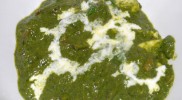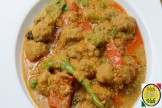Mix fruits korma or Phaldari korma is a brilliant mix of fruits cooked in a silky and aro...

Aloo Gobi Matar is an onion-tomato based curry made with the three veggies. This dish is ...
Brinjal karam with peanut powder is a variety and tasty dish. It is really very yummy whe...
Snake gourd and chana dal curry is a simple south Indian side dish. Snake gourd and chann...

Methi Chaman is a paneer ( Indian cottage cheese) dish with fenugreek leaves and spinach ...

soya nuggets also called meal maker boiled and cooked in sweet and sour gravy....
A popular dish from Malwan is Ambat batata, a potato curry that is sour yet delicious to taste.
Ambat Batata is a typical and popular dish from the... Read More..
About Recipe
Bangaldumpa koora, Uralaikilangu Kuzhambu, Aloo torkari |
|||||||||||||||||||||||||||||||||||||||||||||||||||||||
|
|||||||||||||||||||||||||||||||||||||||||||||||||||||||
Ambat Batata is a typical and popular dish from the Malwan region ; is well known for its sour and tangy savour yet very delicious to taste. This dish is a very simple and easy to cook dish. ‘Ambat’ in Marathi means sour and ‘Batata’ means potato, hence the name Ambat Batata which clearly states that this is a sour potato curry. Ambat Batata taste good when served with hot rice, chapatti, roti or bhakri. Small evenly sized pieces of potatoes are nicely cooked in a tangy and delectable masala made with dry red chillies, few sticks of cinnamon, cloves, black pepper corns, cumin seeds, freshly ground coconut and onions which are lightly fried in very little oil until it gives a wonderful aroma and then ground into coarse paste. This is very refreshing and comforting dish that sparks your taste buds with a medley of flavours.
The cuisine of Malvani is the standard cuisine of the Konkan region of Maharashtra and Goa and some northern parts of West Karnataka. Malvan being a coastal area in the Konkan region has its own distinct way of cooking food. Malvani cuisine uses coconut liberally in various forms such as grated, dry, fried, coconut paste and coconut milk. Many other masala and spices such as dried red chillies, coriander seeds, peppercorns, cumin seeds, cardamom, ginger, and garlic are widely used in their recipes.
Some dishes also use kokum, dried kokum (amsul), tamarind or raw mango to give that superfluous tanginess to the dish. However not all the food from this cuisine is hot and spicy, generally it’s the seafood curries or the non-vegetarian dishes that dominate in spiciness. Some of the popular dishes from this cuisine are Malvani Chicken (a delicious chicken curry cooked with authentic Malvani spices), Malvani Bomblachi Kalvan (fresh Bombay duck fish cooked in a spicy and tangy sauce using authentic Malvani spices), Malvani fish curry, Kekda Masala (Crab Masala), Valachi Usal (“Val”, pulses or more generally known as the Broad Bean/Fava Bean/Field Bean cooked in spicy Malvani style masala gravy), Padval Dalimbi baaji (Snake gourd and Dalimbi or field beans cooked in a spicy curry), Sagoti Chicken Malvani, Kumbdi Vade, and many more.
Another very incredible and popular dish is the Sol Kadhi which is an amazing pink coloured flavoured appetizer drink made from kokum fruit and coconut milk usually taken after eating a scrumptious hot and spicy Konkani or Malvani meal. Potatoes are a pretty versatile vegetable and can be cooked in many ways. They are extensively used in the state of Maharashtra. Batata is the word for potato in some languages, for example, Portuguese, Marathi, Konkani and some Arabic variants.
The English word "potato" itself is derived from the Taíno batata, borrowed via Spanish patata. Generally Malvani dishes have a tangy flavour in their dishes generally coming from the feathery touch of tamarind, mango or kokum. It is also further balanced by adding jaggery to create a little harmony in your taste buds. Kokum is a gentle souring agent that adds a background tang, but never drowns out the main taste. Hence, often added in making fish dishes as it is very much appreciated for its subtler tastes and texture and acts as a neutralizer for masalas giving a unique taste to the dish. Kokum or Garcinia Indica is a deep purple colour fruit where the natural outer cover of the fruit is dried and used as a spice. It gives out a tangy gusto as it contains citric acid, acetic acid, hydroxycitric acid, ascorbic acid, malic acid and garcinol. Hence it needs to be used carefully.
Juice from Kokum is widely used in various curries and also used in making sherbets. These sherbets are especially served during hot summer; it is delicious and has cooling effect, refreshing drink, not only quenches the thirst but also helps prevents dehydration and sunstrokes. Kokum's tanginess can be enjoyed by itself too. There's a candied version called kokum khajur which is very nice to eat. The fresh juice is concentrated with salt to make kokum agal, which when diluted tastes like fruity salt lassi.
The sweet form is kokum sherbet flavoured with a sprinkle of jeera powder gives a warm spiciness. It’s a natural version of fresh Indian beverage. For preparing this mouth-watering and tangy Ambat Batata, firstly add little oil in a pan and fry dry red chilli, cinnamon, cloves, black pepper corns, cumin seeds, freshly ground coconut, and onions. Sauté until slightly golden in colour and blend in a blender to a coarse paste. Heat oil in a pan and when it gets hot, add mustard seeds, cumin seeds, curry leaves, crushed garlic, pinch of hing, turmeric, garam masala and red chilli powder. Mix all the spices well. Add the ambati masala (ground paste) and mix well. Cook this for a minute and then add potato pieces and sauté until they are nicely coated with the masala.
Add water, cover the pan with a lid and cook on a slow flame until the potatoes are nicely cooked. Soak little kokum in water and add in the potato mixture and mix well. Cook this for few minutes and finally sprinkle some coriander leaves and switch off the flame. Serve with roti, chapatti or bhakri.
Tip: Little bit of tamarind extract or lemon juice can be substituted for kokum. Adjust the sourness as per your taste. Apart from potato, Kokum also has several and incredible health benefits. Kokum is vastly used in traditional Ayurvedic medicines to treat skin ailments such as allergies, rashes, burns etc. Kokum fruit is rich in antioxidant and aids weight loss. It can relieve you from gastric problems like acidity, flatulence, constipation and indigestion. It is low in calories and contains no saturated fats or cholesterol and is rich in dietary fibre.
Fresh kokum fruit is a rich source of B-complex vitamins such as thiamin, niacin and folates. Do try this wonderful, tangy, spicy dish from the cuisine of Malvan. Click on the link below to view the making of this recipe:
https://www.vahrehvah.com/ambat-batata
Enjoy Cooking!

santhana krishnan Posted on Sat Sep 15 2012
seems aids infected red chilli ..... hahahuhu
Reply 0 - Replies
Dnyanesh Mankar Posted on Sat Sep 15 2012
Sometimes I just watch the videos for his reaction that he gives after he tastes the dish.
Reply 0 - Replies
Nazima Mehdi Posted on Mon Sep 17 2012
I used to throughly enjoy his videos when they were longer and packed with a great sense of humor. Please chef, could we have our old Vahchef back? He was very entertaining and I loved trying his dishes.
Reply 0 - Replies
Gulzar rashidi Posted on Sat Sep 22 2012
dear chef can you please tell me what cocom ??? thanks
Reply 0 - Replies
SYLFan2008 Posted on Fri Oct 05 2012
Dried petals of the kokum flower: en(.)wikipedia(.)org / wiki / Garcinia_indica You can use imli or tamarind instead, if you cannot find kokum.
Reply 0 - Replies Easy recipes
Easy recipes
 Healthy Recipes
Healthy Recipes
 Dessert Recipes
Dessert Recipes
 Mutton and Lamb
Mutton and Lamb  Indian Bread Recipes
Indian Bread Recipes
 Dal Recipes
Dal Recipes
 Chutney and Pickles
Chutney and Pickles  Indo-Chinese Recipes
Indo-Chinese Recipes
 Snacks and Appetizers
Snacks and Appetizers
 Low Fat Recipes
Low Fat Recipes
 Chaat Recipes
Chaat Recipes
 Biryani and Rice
Biryani and Rice  Curry Recipes
Curry Recipes
 Indian Sweet Recipes
Indian Sweet Recipes
 Egg Recipes
Egg Recipes
 Paneer Recipes
Paneer Recipes
 Chicken Recipes
Chicken Recipes
 Indian tiffins
Indian tiffins
 Egg less Recipes
Egg less Recipes
 Soups and Salads
Soups and Salads
 Indian Sea Food
Indian Sea Food
 Manchurian Recipes
Manchurian Recipes
 Indian Drinks Recipes
Indian Drinks Recipes
 Dinner Recipes
Dinner Recipes
Cyb K Posted on Sat Sep 15 2012
You the best!
Reply 0 - Replies